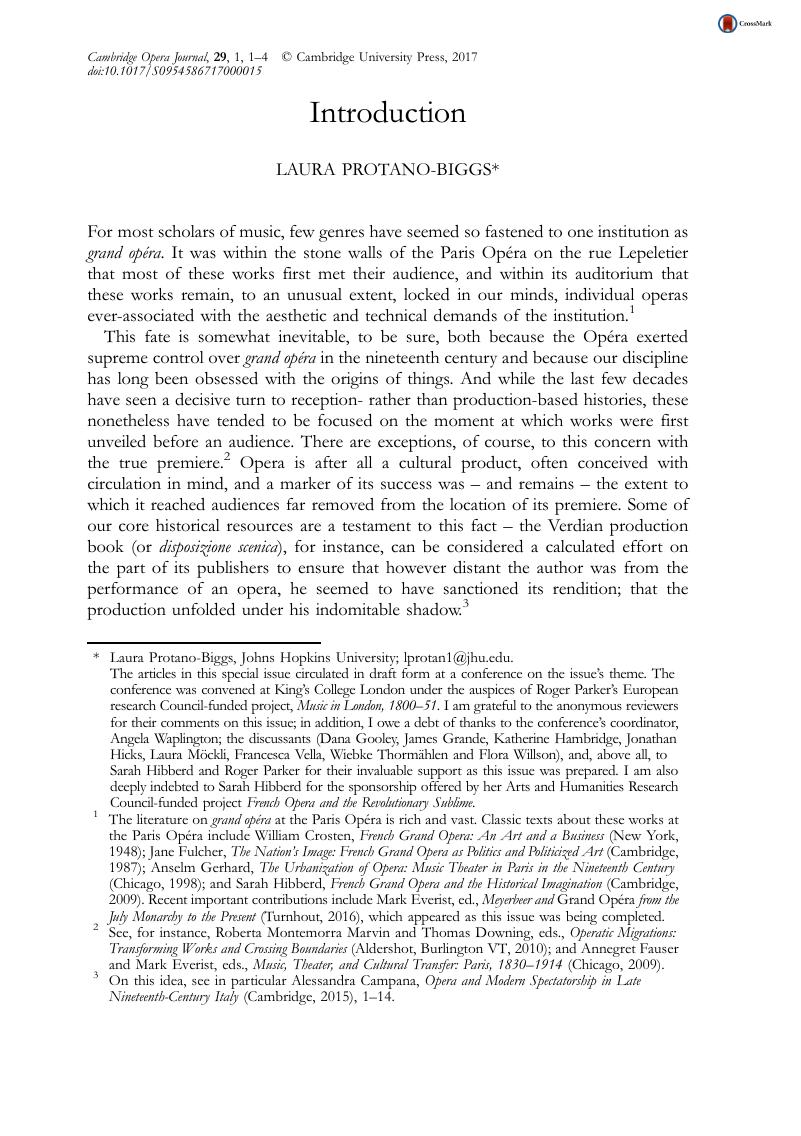Article contents
Abstract

- Type
- Research Article
- Information
- Cambridge Opera Journal , Volume 29 , Special Issue 1: Nineteenth-Century Grand Opéra on the Move , March 2017 , pp. 1 - 4
- Copyright
- © Cambridge University Press 2017
Footnotes
Laura Protano-Biggs, Johns Hopkins University; lprotan1@jhu.edu.The articles in this special issue circulated in draft form at a conference on the issue’s theme. The conference was convened at King’s College London under the auspices of Roger Parker’s European research Council-funded project, Music in London, 1800–51. I am grateful to the anonymous reviewers for their comments on this issue; in addition, I owe a debt of thanks to the conference’s coordinator, Angela Waplington; the discussants (Dana Gooley, James Grande, Katherine Hambridge, Jonathan Hicks, Laura Möckli, Francesca Vella, Wiebke Thormählen and Flora Willson), and, above all, to Sarah Hibberd and Roger Parker for their invaluable support as this issue was prepared. I am also deeply indebted to Sarah Hibberd for the sponsorship offered by her Arts and Humanities Research Council-funded project French Opera and the Revolutionary Sublime.
References
1 The literature on grand opéra at the Paris Opéra is rich and vast. Classic texts about these works at the Paris Opéra include Crosten, William, French Grand Opera: An Art and a Business (New York, 1948)CrossRefGoogle Scholar; Fulcher, Jane, The Nation’s Image: French Grand Opera as Politics and Politicized Art (Cambridge, 1987)Google Scholar; Gerhard, Anselm, The Urbanization of Opera: Music Theater in Paris in the Nineteenth Century (Chicago, 1998)Google Scholar; and Hibberd, Sarah, French Grand Opera and the Historical Imagination (Cambridge, 2009)Google Scholar. Recent important contributions include Everist, Mark, ed., Meyerbeer and Grand Opéra from the July Monarchy to the Present (Turnhout, 2016), which appeared as this issue was being completedGoogle Scholar.
2 See, for instance, Montemorra Marvin, Roberta and Downing, Thomas, eds., Operatic Migrations: Transforming Works and Crossing Boundaries (Aldershot, Burlington VT, 2010)Google Scholar; and Fauser, Annegret and Everist, Mark, eds., Music, Theater, and Cultural Transfer: Paris, 1830–1914 (Chicago, 2009)CrossRefGoogle Scholar.
3 On this idea, see in particular Campana, Alessandra, Opera and Modern Spectatorship in Late Nineteenth-Century Italy (Cambridge, 2015), 1–14 Google Scholar.
4 See, for instance, Gossett, Philip, Divas and Scholars: Performing Italian Opera (Chicago, 2006)CrossRefGoogle Scholar; and Poriss, Hilary, Changing the Score: Arias, Prima Donnas, and the Authority of Performance (Oxford, 2009)Google Scholar.
5 Exceptions appear in the notes to all the articles in this volume, notably including Newark, Cormac, ‘“In Italy We Don’t Have the Means for Illusion”: Grand Opéra in Nineteenth-Century Bologna’, Cambridge Opera Journal 19 (2007), 199–222 CrossRefGoogle Scholar; Sivouja, Anne, Ander, Owe, Broman-Kananen, Ulla-Britta and Hesselager, Jens, eds., Opera on the Move in the Nordic Countries during the Long 19th-Century (Helsinki, 2012)Google Scholar; Fuhrmann, Christina, Foreign Opera at the London Playhouses: From Mozart to Bellini (Cambridge, 2016)Google Scholar; and chapters by Milan Pospíšil, Melanie von Goldbeck and Jennifer C. H. J. Wilson in Everist, ed., Meyerbeer and Grand Opéra. A core resource on the circulation of grand opéra outside Paris remains ‘Part Four: Transformations of Grand Opera’, in The Cambridge Companion to Grand Opera, ed. David Charlton (Cambridge, 2003), 321–422.
- 1
- Cited by




